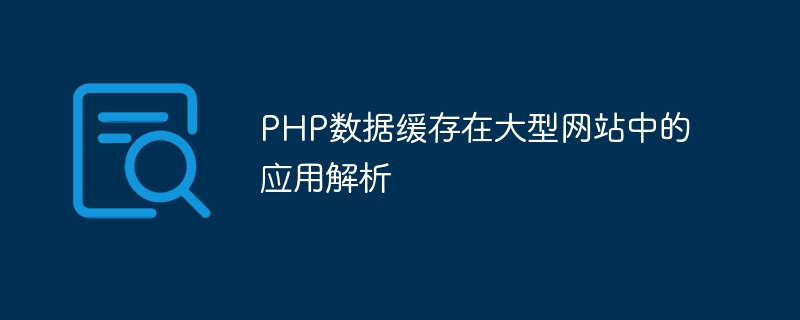

Application analysis of PHP data cache in large websites
With the rapid development of the Internet and the continuous emergence of large websites, how to improve the performance of the website has become an important issue The problem. As a popular server-side scripting language, PHP's performance optimization has always been one of the focuses of developers. Among them, data caching is an important way to improve website performance. This article will introduce the analysis of PHP data caching in large websites and give corresponding code examples.
1. What is data cache?
Data caching refers to storing data in memory to improve the speed of data access. In large websites, database read and write operations are very frequent, and database operations are usually time-consuming operations. In order to reduce the pressure on the database and improve the response speed of the website, some frequently used data can be cached in memory, thereby reducing access to the database.
2. Implementation method of PHP data cache
Global variables in PHP always exist during script execution and can be used Store some commonly used data. By assigning the data that needs to be cached to a global variable, the data can be used throughout the script, avoiding repeated queries to the database.
// 将数据缓存到全局变量中
function getData() {
global $cache;
if (empty($cache)) {
$cache = // 从数据库中获取数据
}
return $cache;
}
// 在其他地方使用缓存的数据
$data = getData();
// 使用$data进行操作PHP provides a series of functions for operating files, which can cache data into files. The data can be serialized and written to a file, and then the file can be read to parse the data when needed, thereby achieving fast access to the data.
// 将数据缓存到文件中
function getData() {
$cacheFile = 'data.cache';
if (file_exists($cacheFile)) {
$data = unserialize(file_get_contents($cacheFile));
} else {
$data = // 从数据库中获取数据
file_put_contents($cacheFile, serialize($data));
}
return $data;
}
// 在其他地方使用缓存的数据
$data = getData();
// 使用$data进行操作
In addition to global variables and file caching, you can also use specialized memory caching systems, such as Redis, Memcached, etc. These memory cache systems have high-speed reading and writing capabilities and good scalability, and are suitable for high-concurrency website environments.
// 连接Redis服务器
$redis = new Redis();
$redis->connect('127.0.0.1', 6379);
// 将数据缓存到Redis中
function getData() {
global $redis;
$cacheKey = 'data_cache';
if (!$redis->exists($cacheKey)) {
$data = // 从数据库中获取数据
$redis->set($cacheKey, serialize($data));
} else {
$data = unserialize($redis->get($cacheKey));
}
return $data;
}
// 在其他地方使用缓存的数据
$data = getData();
// 使用$data进行操作
3. Data cache update mechanism
For frequently updated data, the cached data needs to be updated in time, otherwise data inconsistency will occur. Common data cache update mechanisms are:
// 每隔一定时间清除缓存
function clearCache() {
$cacheFile = 'data.cache';
unlink($cacheFile);
}
// 在更新数据的地方调用清除缓存的函数
updateData();
clearCache();// 更新数据时同时更新缓存
function updateData() {
// 更新数据库中的数据
// 更新缓存中的数据
$cacheFile = 'data.cache';
file_put_contents($cacheFile, serialize($data));
}4. Notes
Summary:
Data caching is one of the important means to improve the performance of large websites. By rationally selecting the caching method and update mechanism, the pressure on the database can be effectively reduced and the response speed of the website can be improved. PHP provides the implementation of multiple caching methods, and developers can choose and optimize according to actual needs.
(The above code examples are for reference only, and need to be adjusted and expanded according to specific circumstances in actual applications.)
The above is the detailed content of Application analysis of PHP data caching in large websites. For more information, please follow other related articles on the PHP Chinese website!